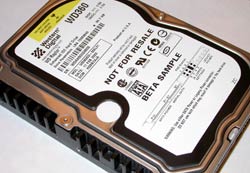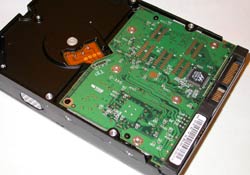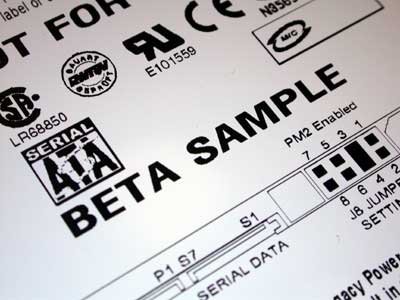Western Digital Raptor Preview: 10,000RPM & Serial ATA
by Anand Lal Shimpi on March 7, 2003 2:48 AM EST- Posted in
- Storage
Raptor - A Desktop or Enterprise Animal?
The WD Raptor is an interesting beast as it has characteristics of both desktop and enterprise level hard drives. The 10,000RPM spindle speed that has previously been reserved for enterprise-class and high-end workstation storage solutions, however the Serial ATA interface makes it more accessible to end users than similar SCSI solutions. The situation gets even more complicated when you look at the other features of the drive; the Raptor promises a cheaper price tag than 10,000RPM SCSI drives, as well as a small 36GB introductory capacity instead of the 100GB+ sizes we're used to seeing on desktop drives. To top it all off, the WD Raptor comes with a 5 year warranty, another selling point reserved for the workstation and enterprise-class users.
 |
 |
Given the description of the Raptor, you'd think that Western Digital would be going after the SCSI market with the drive. But with the incredible success and performance of Western Digital Special Edition Caviar drives, many want to believe that the Raptor will be the holy grail of desktop hard drives - a performance inspiring reason to adopt Serial ATA.
Before we get into looking at the Raptor's performance, you have to realize what it is not. The Raptor is not 10,000RPM version of Western Digital's 8MB cache IDE drives; making a drive spin at 10,000RPM is not as simple as turning a knob, there's much more engineering that must go into the effort. The higher your spindle speed, the more heat is generated and the more you have to worry about dealing with reliability. With Western Digital offering their longest warranty on the Raptor, you can bet that the drive was designed from the ground up to be as reliable as possible and not a simply re-use of their IDE drive technology. If anything, a 10,000RPM version of the current Special Edition drives would reduce reliability significantly; it's clear that this wasn't an option for the folks at Western Digital.
What would make more sense is for Western Digital to borrow the technology used in their discontinued 10,000RPM SCSI drives from a couple of years ago and update them with higher density platters and larger buffers. Western Digital's Enterprise line of 10,000RPM SCSI drives were already reliable enough to run at such high spindle speeds, but their platters weren't nearly as dense as today's and they featured smaller/slower buffers. Instead of re-engineering the current IDE designs, it would make much more sense for WD to take the old SCSI designs and update them with newer technology - primarily denser platters, newer heads and faster buffers. Things like prefetch algorithms would also be improved, assuming this was the route Western Digital took. The end result would be essentially a SCSI drive, but with a Serial ATA interface and a cheaper price tag than competing SCSI solutions.
Obviously Western Digital isn't going to reveal their engineering approach to the Raptor for the world (and competition) to see, but looking at the drive from multiple perspectives is important as you'll come to see.

Note that the Raptor drive we received for review is an engineering sample, and may not be representative of final shipping performance. We received the drive after Western Digital had stated they had begun shipping the Raptor drives to distributors, so we do believe that performance won't change significantly between what we have here and retail products.










0 Comments
View All Comments